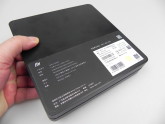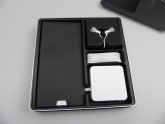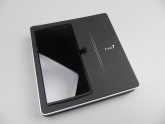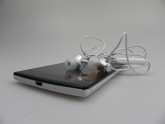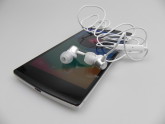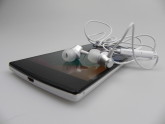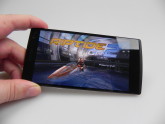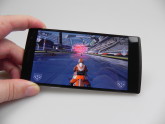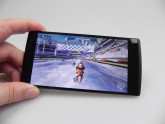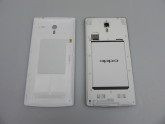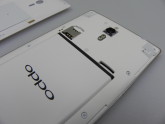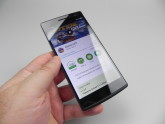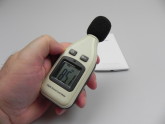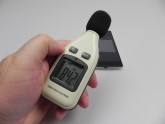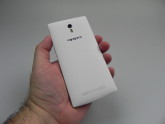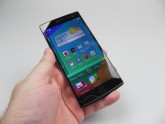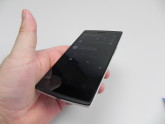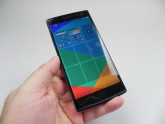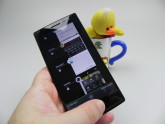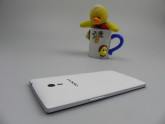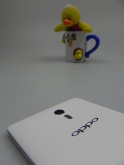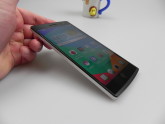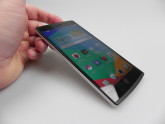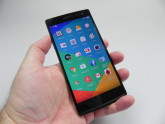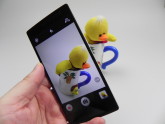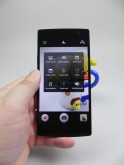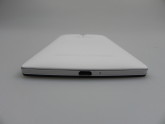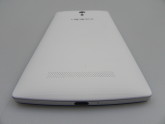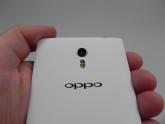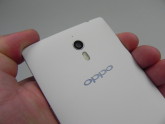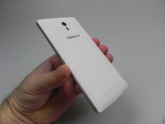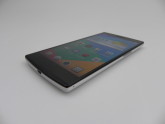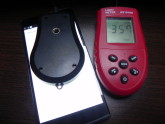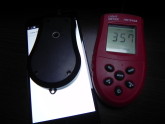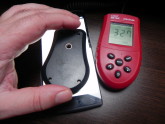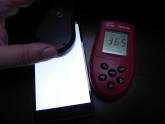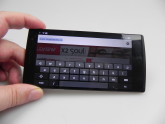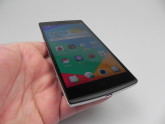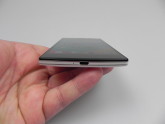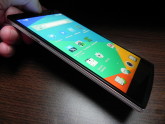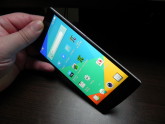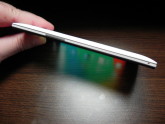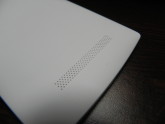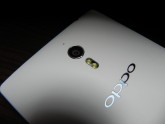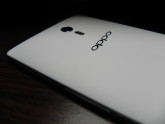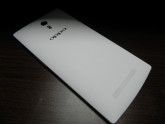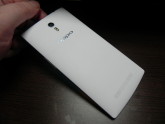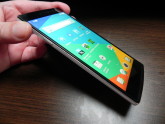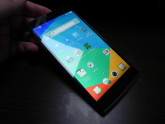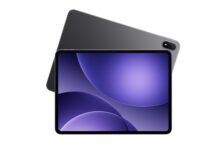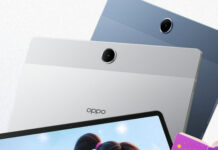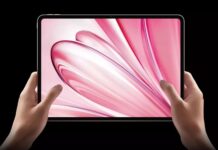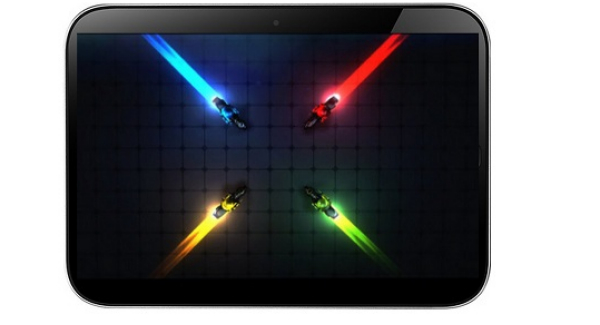The Oppo Find 7a is a phablet that came to us for review purposes, as we were taking a break from the usual tablets we tested. The Oppo Find 7a is the Full HD model, while the Oppo Find 7 is a Quad HD phone with 1 GB RAM extra. We tested the first one, that was launched in the Spring of 2014 and now it’s priced at around $625 on Amazon.
Its design is very similar to the one of the OnePlus One, since we are dealing with a 5.5 inch phablet after all. This one measures 9.2 mm in thickness, while the OnePlus measures 8.9 mm in waistline. The Find 7a weighs 170 grams, while the OnePlus One only 162 grams and they both have the same width and length, give or take a millimeter.
The Find 7a comes in black or white, it offers good grip and slim enough bezels. Its front side is a fingerprint magnet and the back has a dotted texture. The phablet comes with a solid build and a rectangular format, that’s only a little rounded at the top and bottom. The case is made of polycarbonate and there is chrome on the sides, plus in the camera are and buttons.
We can also find similarities to the Oppo Find 5 here. Upfront, the Oppo Find 7a brings an earpiece, sensors, front camera and barely visible capacitive buttons. There’s a discrete blue notification light at the bottom, while at the back we find the microphone, camera, dual LED flash, speaker and a removable cover, that’s pretty hard to pry open.
Below it there’s the microSD card slot, microSIM slot and battery. The top features the audio jack, while the bottom hosts another microphone and a microUSB port. On the left side we find an On/Off button and on the right volume buttons, all of them very hard to press, because they protrude too little out of the device. This is a massive phone, that’s solid and comfy aside from the buttons.
Now as far as the hardware goes, this model packs a 5.5 inch Full HD IPS LCD display, with Gorilla Glass 3 protection and a 72.9% screen to body ratio. The CPU inside is a quad core Snapdragon 801 clocked at 2.3 GHz, with an Adreno 330 GPU. The RAM quantity is 2 GB and specs also include 16 GB of storage, a microSD card slot with support for up to 128 GB extra storage, a 13 megapixel back camera with dual LED flash and a front 5 MP shooter.
As far as connectivity is concerned, we’re completely covered, with Bluetooth 4.0, WiFi b/g/n dual band, WiFi Direct, DLNA, GPS, NFC, microUSB 2.0 with USB OTG, quad band GSM/GPRS/EDGE, LTE and HSPA. Finally, the Oppo Find 7a brings an accelerometer, proximity sensor and active noise canceling. The battery inside is a Li-Po unit with a capacity of 2800 mAh and in our test it achieved 9 hours and 1 minute of HD video playback in a loop with WiFi on and brightness at 50%.
Thus, we beat the OnePlus One and its 8 hours and 54 minutes of playback, but we were below the Galaxy S5 and its 11 hours. The charging is incredibly fast, so in one hour and 20 minutes we get to 100%. Also, 30 minutes of charge bring the battery to 70% thanks to quick charging technology. The Settings include a Power Saving mode, that lowers brightness, closes WiFi, Bluetooth, data and GPS. You can also close touch feedback, by the way.
On this Oppo phone there’s also a battery reminder, that reminds you to charge the phone when the power is less than 40% at night. Overall, this is a good battery and it’ll give you about a day and a half of average usage. Moving on to the audio side of things, there’s a custom music player in here, that shows both local songs and online tunes. There are also themes available for the player.
This player features a simple and minimal UI and the actual acoustic experience is a loud and clear one, with good bass and all the notes are heard OK. The sound is crisp and we’ve got a Maxx audio option, as well as technology from Waves Audio, that makes the sound more natural. The settings include shake to sip, auto download lyrics and album arts and Maxx Audio Modes.
Those are Music, Movies, Games and Custom, each with a different setup. They have a custom graph to tweak and mess around with high and low sounds. There’s bass, treble, volume and dialog to mess with via sliders. The player offers FLAC support and Dirac HD for headphones, which is a technology that optimizes frequency response. The headphones bundled with this phablet look nice, they’re slightly sloped, comfy and have great noise isolation.
This accessory comes with a deep bass, loud and clear sound and a pretty clear experience. The headphones are on Apple or Samsung level, which is quite a compliment. With Dirac activated you can hear extra percussions and I have to say I’m impressed by the audio experience of this phone. There’s no FM radio here, in case you’re wondering. We used a decibelmeter on this device and achieved 85.1 dBA at the back and 84.2 dBA at the front. The iPhone 6 Plus meanwhile reaches 83.8, but the OnePlus One gets to 90.5 dBA.
Overall, the audio is good and it’s clearly above all the iPhones. Now, as far as the screen goes, this one is a 5.5 incher IPS LCD with a 1920 x 1080 pixel resolution. The video player available here is a custom one, with DivX and Xvid support, as well as AVI and MKV. The video experience is crisp, clear, bright and there are wide view angles to enjoy, with a vivid image too. This is a JDI Display, that’s a bit reflective in sunlight and its colors are maybe a bit too cold.
The pixels are of the RGB Stripe kind and the LUX level is actually split in 3. The top part of the phone shows 365 LUX, the mid part 357 LUX and the bottom 327 LUX. By the way, the OnePlus One also showed various brightness levels on the screen. Anyway, we’re overall below the OnePlus One, that achieved 404 LUX units, but we’re pretty close to other popular phones, like the Xperia Z2 and its 366 LUX, or the LG G3 and its 343 LUX.
Oppo Find 7a has an OK display, but it doesn’t break any records, that’s for sure. It’s also not a weak screen, in case you’re wondering. The Settings include various types of screen lock (Cards, Travel, Weather and more), Easy Light settings (notification bar that lights up at the bottom), key lights, fonts and holiday wallpapers.
The smartphone packs a 13 megapixel back camera, with the same Sony sensor as the one of the OnePlus One, the IMX214. We get a dual LED flash here, F/2.0 aperture, and the 1/3.06 inch sensor is a CMOS with BSI. To that we add a 5 MP selfie camera. This camera takes 50 megapixel interpolated shots and does RAW capture. The UI is minimalistic and on the left side we’ve got a front camera shortcut, flash options, as well as settings. The latter include resolution (13 megapixel in 4:3 or 10 MP in 16:9). We’ve also got timer, shutter sound, white balance, voice shot and scene mode as options.
The video capture includes 720p, Full HD, slow mo, HDR and 4K capture options. At the top of the screen you can find location and storage options. Then the camera offers more modes, like Normal, HDR, HD Picture (50 MP shots achieved through 10 MP shots glued together, with impressive details), Beautify, Panorama, Slow Shutter (auto, 0.5 seconds, 1 second, 2 seconds, 4 seconds, 8 seconds, 16 seconds and 32 seconds), Audio, GIF and RAW. Slow Shutter capture takes longer exposure shots and it’s good for low light capture.
Audio records acoustics with photo captures. Other capture options are Scan/Paste and Poster/Magazine Search. RAW capture offers DNG format pics. The back camera has an OK focus speed, fast capture and 4X zoom. Oppo Find 7a captures shots with good colors (a bit on the cold side), it can take a nice blue sky shot and offers good details, plus OK exposure and white balance.
The shadows are nicely captured and HDR was pretty much OK. Macros were excellent and you can check them out in the gallery here. The camera is good even with the sunlight in front of it and there’s no halo effect, luckily. The sun does tend to burn some shots, though. I like particularly the way the blue is represented here, while the reds aren’t that good and green is OK. HDR is exaggerated, making shots a bit too bright for their own good.
Panorama is not very wide, but the stitching is fast. The big 50 megapixel shot has a resolution of 8160 x 6120 pixels and it has a huge level of detail. This smartphone is able to take good selfies, all of them looking crisp and it even handles low light in a decent way. There’s no noise and we’ve got a dual LED flash in the mix.
The videos captured by the Oppo Find 7a include a first Full HD clip in MP4 format, with 30 FPS frame rate and 8 Mbps bit rate. Audio is very good, but the brightness is a bit of a letdown. Focus is OK and stabilization doesn’t impress. The second video has good focus and good colors, but again the stabilization disappoints and bitrate is low.
The third video offers good white balance, exposure and poor bitrate again. The HDR video highlights details, that look really nice this way. I would say that quality of the pictures and videos is about the same as the one of the OnePlus One, but below the Galaxy S5 and Xperia Z2. Editing includes options like shadows, auto fix, fill light, FX, saturation, crop, rotate and more.
The device’s temperature test revealed a temperature of 40.9 degrees Celsius after playing 15 minutes of the game Riptide GP2, so there’s only a slight overheating here. Oppo Find 7a uses Chrome as its web browser and it provides a fast browsing experience. The keyboard is a stock one and also includes Swype. As far as the phone features are concerned, there’s an anti harassment filter option, the option to intercept spam calls, smart dial, holiday mode, vibrate when call starts and the earpiece is quite loud.
The sound is clear and the phone offers very good noise cancelling. Now as far as the benchmarks are concerned, we compared the Oppo Find 7a with the OnePlus One, LG G3 and Samsung Galaxy S5. Here are the results:
All 4 models have a Snapdragon 801 processor, and 3 of them have full HD screens and one Quad HD. This model wins 4 out of 10 battles and 5 out of 10 in front of the OnePlus One. It can run Riptide GP2 with all details on high and no problems. As far as software goes, this unit runs Android 4.3 with Color OS 1.2.0 on top. This is an Android skin that Oppo uses, plus some versions of the OnePlus One in China.
There’s lots of customization here, icons look nice and you can tweak themes, effects, icons and more. The bottom part of the UI includes a customizable dock and the widgets are placed separately from the app list. If you press the menu button, you can trigger the widgets and wallpaper area. Oppo includes here something called Exclusive Space, that focuses on Photo or Music, as an entire homescreen.
Exclusive Space is a special media page with Polaroid-style pictures and shortcuts, plus a timeline. The same applies for music and when both of these homescreens are applied the status bar is gone. The UI features up to 9 homescreens and if you keep the Home button pressed, you can trigger the multitasking and task cleaner. The dropdown area features a special gesture pad, where you can draw in order to trigger new apps and features.
The center and Right area feature Quick Settings and Notifications, No Disturb Mode, Power Save, End All and more. Settings include Security, Guest Mode, App Encryption, Virus Detection, Data Saving, Gestures and overall the Settings section is clean and very well organized. You can place widgets on the lockscreen and double tap to wake the device.
Overall Color OS is nice and I like the gestures and security features, plus customization. The preinstalled apps list includes Calendar, Weather, Notes (draw, handwrite), Files (file manager), Lock Now, Email, Themes, Photos, Facebook, News and Weather, Photos, Google+, Gmail, Contacts, cloud Service and Car Mode. There’s also a Tools folder, with a Calculator, flashlight, sound recorder, compass, service direction, downloads, Backup and Restore.
Now let’s see the verdict.
Here are the Pros:
incredibly fast charging
nice Maxx audio features
nice headphones
good benchmarks
runs 3D Games fine with max details
good pictures
nice special options for capture
nice interface
And the Cons:
massive design
costs more than OnePlus One but offers similar experience
battery could be better
display doesn’t stand out
not impressive video capture
We give this model an 8.7 out of 10 for design, a 9 out of 10 for hardware and a 9.3 out of 10 for UI and OS. The final grade is 9 out of 10, but the price is a big minus, so we’re dropping 0.4 out of 10. The final grade is now 8.6 out of 10 and this feels like an overpriced OnePlus One, with lesser features and UI. The choice is yours, but some multimedia aspects are top notch here.
[youtube st62SBm3sO4 660 520]
Post Footer automatically generated by Add Post Footer Plugin for wordpress.














